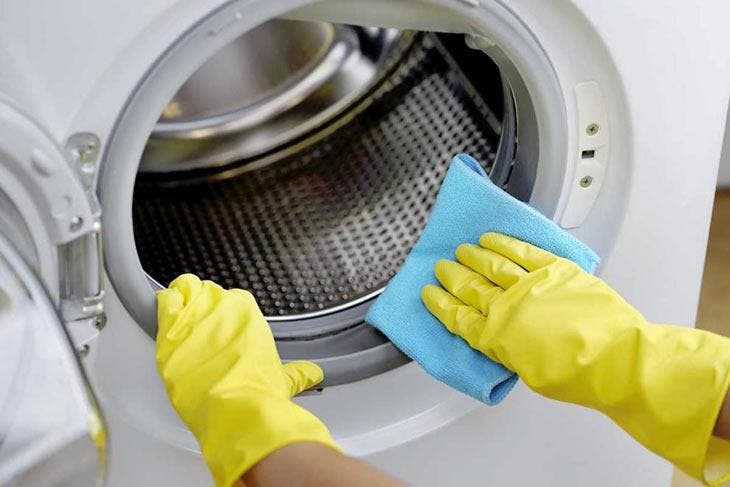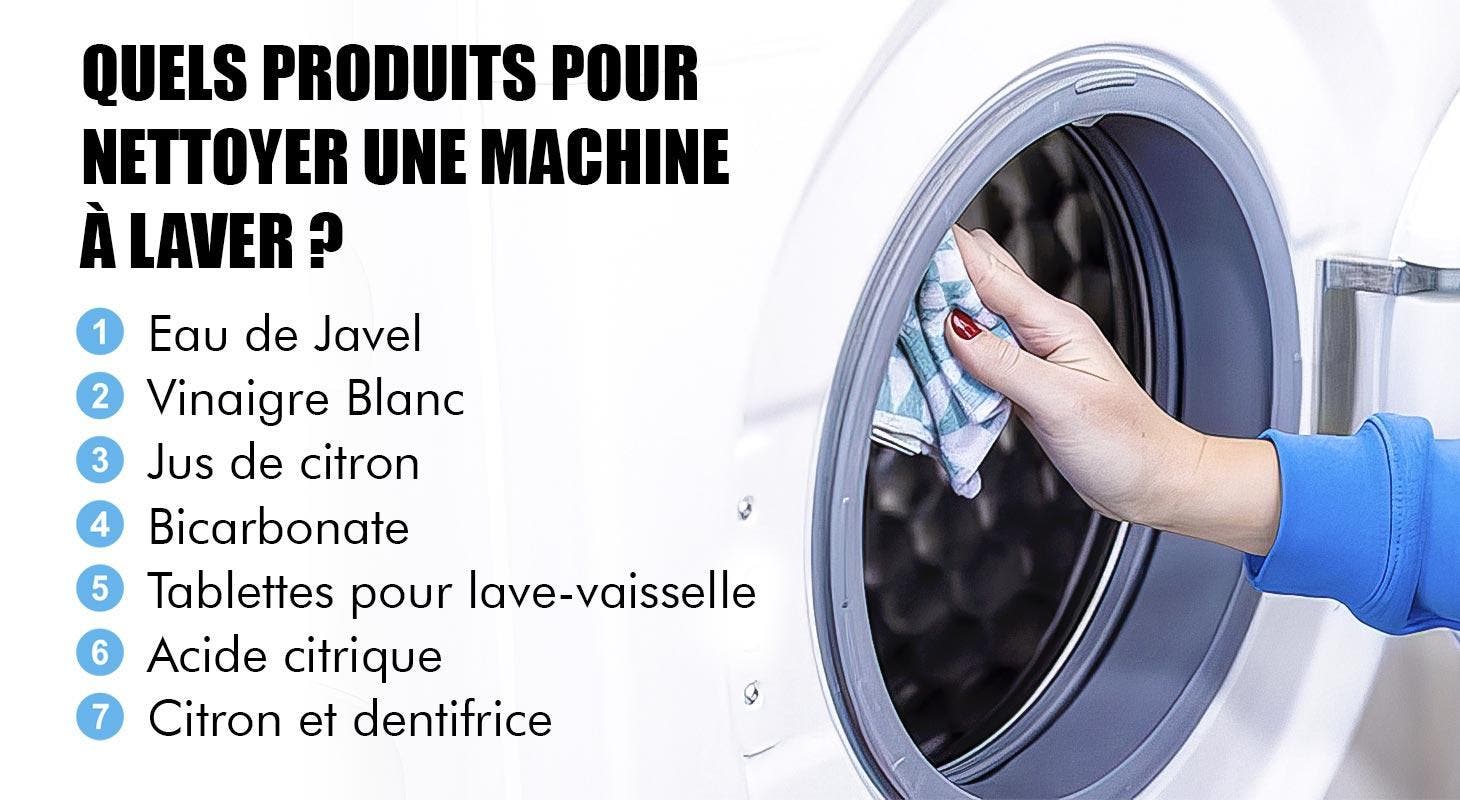Why is it important to clean your washing machine?

One thing is for sure: the washing machine makes your life easier in many ways. Thanks to it, your clothes and linens are always clean. The time savings are invaluable since you avoid manual washing most of the time. But, don’t think this device is foolproof. If you don’t take care of it properly, you can expect a lot of inconvenience and a limited lifespan. A single watchword: impeccable hygiene. Alas, admit it, you often tend to neglect its maintenance. However, there is no secret, to preserve your laundry and make your machine last longer, regular cleaning is essential! Otherwise, a lack of maintenance will affect it over time and prematurely reduce its lifespan. And that’s not all: it also triggers the accumulation of microorganisms inside the device, which are primarily responsible for stains and bad odours.
Eliminate bacteria and mold
Are you worried about unpleasant surprises? Tell yourself that it is quite possible to prevent mold from creeping into your washing machine. All you have to do is establish good habits and adopt the right gestures! As soon as you feel that your laundry is starting to soak up a musty smell, have the reflex to regularly run a wash cycle at a very high temperature (70-95°C) to effectively fight against ugly mold. At the end of each cleaning, it is also recommended to dry the accessible parts of the appliance thoroughly. Remember, humidity is your No. 1 enemy! So always remember to ventilate your washing machine by leaving the drum and laundry drawer slightly open. This simple gesture helps to greatly limit the multiplication of microorganisms that grow quickly in humid environments.
Preserve the performance of your washing machine
To keep your machine performing well over the long term and keep it running smoothly, be sure to clean the main areas regularly so that they are free of limescale.
Extend the life of your washing machine
It would be a real waste to clumsily damage your device and replace it before its time. Especially since modern machines are rather expensive! Why break the bank when all you have to do is, once again, handle your washing machine properly by adopting good habits.
- Don’t overload it! Each machine has a permissible weight that is usually between 10 and 23 kilos (depending on the size of the drum). Don’t exceed this limit, otherwise you won’t be safe from damage and unpleasant surprises.
- After each wash, get into the habit of leaving the lid open for the rest of the day. This way, you’ll help it ventilate properly and reduce the risk of mold growth. And, at the same time, to avoid bad smells!
- Periodically clean soap and fabric softener containers with vinegar. In these compartments, chemical residues often accumulate and eventually create unsightly stains on the laundry.
- Clean your washing machine at least once a month to keep it always at 100% efficiency.
The telltale signs that should prompt you to clean the washing machine
Can you imagine your life today without a washing machine? Almost impossible, isn’t it?Especially when you have a large family. So, since it is a valuable ally, the least we can do is take care of it properly. However, with the hectic lives we all lead, we can indeed be negligent in this area. Fortunately, there are some signs that can alert you to possible operational problems. If your washing machine shows you any of these 3 signs, you need to clean it urgently:
Bad odours
Despite being freshly washed, do your clothes come out with an unpleasant smell? The problem can be due to the build-up of impurities in both the drum and the filters. This is a sure sign that you need to clean your washing machine as soon as possible.
Stains on clothing
Are you distraught when you notice strange oily stains on the fabrics of your clothes, right after washing? Don’t worry, by cleaning your machine thoroughly, this problem will no longer be relevant. But be careful, if the phenomenon persists, it may be due to a mechanical breakdown. At this point, it is best to contact the technical service to prevent this from happening often.
Unusual noises
Do you hear a weird rattling noise that occurs during washing? Then there may be a foreign object in the drum or in the drain pump. Check these components carefully to find the source of the problem and protect your laundry.
8 Tips for Cleaning Your Washing Machine

The good news is that you won’t need a specific or expensive “cleaner” to clean your washing machine. A few common products, including excellent natural methods, can do the trick.
Bleach
Use sparingly as this is an environmentally unfriendly chemical solution. Not to mention that this product, if used incorrectly, may stain your laundry.
How to use:
White vinegar
This eco-friendly and inexpensive disinfectant is a powerful ally for deep cleaning your machine. As an added bonus, it kills bacteria and eliminates bad odors.
How to use:
Lemon juice
Lemon is an outstanding cleanser and disinfectant, especially thanks to its acidity. It will not only banish bacteria but also deodorize the place by leaving a pleasant tangy scent. When it comes to cleaning your washing machine, always count on the potential of lemon juice. Plus, if combined with vinegar, the result is even more remarkable!
How to use:
Baking soda
Like white vinegar, baking soda is also renowned for its cleaning and deodorizing performance. As a bonus, it is also eco-friendly and economical. The icing on the cake: it’s a first-class anti-limescale agent!
How to use:
Dishwasher tablets
Yes, it may surprise you, But these tablets are super effective at cleaning the washing machine. By the way, if you don’t have any cleaner on hand, these tablets will come to the rescue.
How to use:
Citric acid
A suitable remedy for descaling the inside of the washing machine? Citric acid will be an unsuspected ally. Thanks to its properties, you will be surprised by the potential of this cleaning agent that will have no mercy on limescale and scale.
How to use:
Lemon & Toothpaste
Does the idea sound preposterous to you? Admittedly, mixing the two may seem unusual, but the combination of lemon and toothpaste is a popular and proven homemade trick. And that’s thanks to the cleaning and deodorizing properties of these two ingredients. With its acidic properties, lemon juice will break down residues and banish unpleasant odors. Toothpaste, on the other hand, has tremendous stain remover and stripping abilities.
How to use:
The Dish Sponge
Did you know that a kitchen sponge can be very useful for you? This simple method has even quickly gone viral on social media: in fact, it has the ability to remove all the hair from the clothes in the machine during the washing process. It’s very simple, you will only have to install the sponge in the drum at the same time as the dirty laundry. Once the program is launched, it will absorb all this little detritus. And presto, you can say goodbye to lint and hair sticking to the walls of the device!
How do I clean the drum of the appliance correctly?
Here are the steps you need to follow to effectively clean your washing machine’s drum:
Step 1- Disinfect the seals of the washing machine
With time and use, it’s no wonder that seals accumulate a lot of dirt. Often, in fact, you don’t even notice how dirty they are because of the crevice that hides the residue. But, today, you’re going to roll up your sleeves and thoroughly disinfect this winding area. To perform this task, you’ll need to use white vinegar or hydrogen peroxide (not both at the same time!).
Here’s how to do it:
Step 2- Turn on the washing machine to its hottest setting
Once you’ve finished cleaning the seals, you can now move on to cleaning the inside of your washing machine. This step is relatively simple.
Here’s how to do it:
Step 3- Insightful Mixing Baking Soda and Vinegar
After deferringOnce you have infected the inside of your washing machine, continue with cleaning the drum.
How to use:
Step 4- Let your machine run a full cycle
Have you completed the steps above? Now it’s time to let your washing machine run a full cycle with only water. This rinse will remove the residue of baking soda and vinegar, as well as any other remaining dirt inside.
Step 5 – Cycle again with hot water
Although this is optional, it is still advisable to make sure that there is no dirt residue left. Therefore, there is nothing to stop you from letting your washing machine go through another full cycle with hot water. For impeccable hygiene!
Mistakes to avoid when cleaning your washing machine
Don’t feel targeted, we all do! Few people read the machine manual, it must be admitted. Therefore, we sometimes unintentionally make gross mistakes. And it’s the device itself that ends up paying the price after a while!
Use of abrasive products
Yes, so if you take the time to read the instruction manual, you will know that there are very specific types of detergents to use on your washing machine. However, if you have missed this episode, you are very likely to use abrasive agents that can affect your washing machine after several uses. In other words, if the foam doesn’t rinse off completely, it can stain your clothes and cause residue to build up in the machine.
Neglecting filter cleaning
It’s important to remember that a clogged filter is bound to develop mold and mildew if it’s not cleaned regularly. What are the implications? The particles will seep into your clothes during washing and cause allergic reactions. So prevention is better than cure!
Insufficient cleaning frequency
As confusing as it sounds, your washing machine needs regular cleaning. Too little or really inconsistent maintenance can damage it before its time. To avoid problems, it is recommended to do a deep cleaning once a month or at least after about 30 wash cycles. And as you can see, this is a really necessary evil!
FAQ
How do you remove black deposits from the washing machine?
To rid your washing machine of all this mold, which is responsible for bad odors, there is a simple cleaning solution. Soak a microfiber cloth with bleach and wipe the laundry drawer thoroughly (inside and out). Pay particular attention to corners, where black mold accumulates more easily. Continue until there is no trace of black deposits left. Then rinse thoroughly with lukewarm water and let dry properly.
Where to put white vinegar in the washing machine?
The disadvantage of chemical detergents, in addition to not being environmentally friendly, is that they tend to make fabrics rougher over time. Not to mention the residue left behind by some commercial fabric softeners. This is why the alternative of white vinegar is often popular: this product will not only effectively clean your laundry, but it will also soften fabrics and deodorize clothes. Simply pour a small amount into the fabric softener drawer of your washing machine to see the result on the laundry after washing.
How do you clean a smelly washing machine?
If you smell a bad smell obviously coming from the drum, there is a drastic solution: let it soak overnight with water and white vinegar. The LendemaiIn the morning, you can rinse it normally to remove the residue of the product. And you’ll see, the drum will be deodorized!





